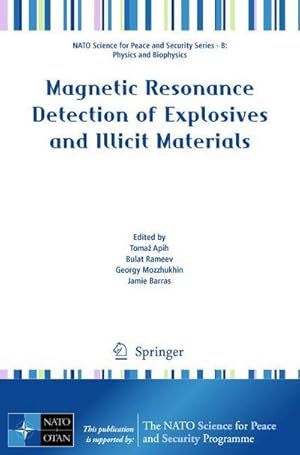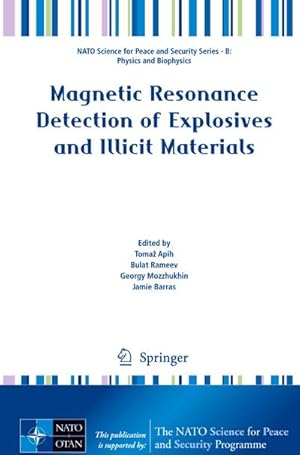apih toma (2 Ergebnisse)
FeedbackSuchfilter
Produktart
- Alle Product Types
- Bücher (2)
- Magazine & Zeitschriften (Keine weiteren Ergebnisse entsprechen dieser Verfeinerung)
- Comics (Keine weiteren Ergebnisse entsprechen dieser Verfeinerung)
- Noten (Keine weiteren Ergebnisse entsprechen dieser Verfeinerung)
- Kunst, Grafik & Poster (Keine weiteren Ergebnisse entsprechen dieser Verfeinerung)
- Fotografien (Keine weiteren Ergebnisse entsprechen dieser Verfeinerung)
- Karten (Keine weiteren Ergebnisse entsprechen dieser Verfeinerung)
- Manuskripte & Papierantiquitäten (Keine weiteren Ergebnisse entsprechen dieser Verfeinerung)
Einband
Weitere Eigenschaften
- Erstausgabe (Keine weiteren Ergebnisse entsprechen dieser Verfeinerung)
- Signiert (Keine weiteren Ergebnisse entsprechen dieser Verfeinerung)
- Schutzumschlag (Keine weiteren Ergebnisse entsprechen dieser Verfeinerung)
- Angebotsfoto (2)
Gratisversand
Verkäuferbewertung
-
Magnetic Resonance Detection of Explosives and Illicit Materials
Verlag: Springer Netherlands, 2013
ISBN 10: 940077267X ISBN 13: 9789400772670
Anbieter: AHA-BUCH GmbH, Einbeck, Deutschland
Taschenbuch. Zustand: Neu. Druck auf Anfrage Neuware - Printed after ordering - Detection of concealed explosives is a notoriously difficult problem, and many different approaches have been proposed to solve this problem. Nuclear quadrupole resonance (NQR) is unique in many ways. It operates in a safe AM radio frequency range, and it can remotely detect unique 'fingerprint' (NQR spectrum) of many explosives, such as TNT or RDX. As such, the detection of target does not depend on the shape or material of the container, or the presence of metallic object such as triggers etc. Spectra of chemically similar compounds differ enough that their presence never causes interference or false alarms. Unfortunately, widespread use is prevented due to low sensitivity, radiofrequency interference from the noisy environment, and inability to detect liquid explosives. This book presents current state of the art of the attempts to overcome NQR sensitivity problem, either by increasing the strengths of signals generated, or by increasing the specificity of the technique through a better understanding of the factors that affect the quadrupolar parameters of specific explosives. The use of these specific quadrupolar parameters is demonstrated on signal processing techniques that can detect weak signals, which are hidden in a noisy background. The problem of differentiation of liquid explosives and benign liquids in closed containers is approached by measurements of different nuclear magnetic resonance (NMR) parameters. As shown, a couple of solutions has reached a prototype stage and could find their use in a near future.
-
Magnetic Resonance Detection of Explosives and Illicit Materials
Verlag: Springer Netherlands, 2013
ISBN 10: 9400772645 ISBN 13: 9789400772649
Anbieter: AHA-BUCH GmbH, Einbeck, Deutschland
Buch. Zustand: Neu. Druck auf Anfrage Neuware - Printed after ordering - Detection of concealed explosives is a notoriously difficult problem, and many different approaches have been proposed to solve this problem. Nuclear quadrupole resonance (NQR) is unique in many ways. It operates in a safe AM radio frequency range, and it can remotely detect unique 'fingerprint' (NQR spectrum) of many explosives, such as TNT or RDX. As such, the detection of target does not depend on the shape or material of the container, or the presence of metallic object such as triggers etc. Spectra of chemically similar compounds differ enough that their presence never causes interference or false alarms. Unfortunately, widespread use is prevented due to low sensitivity, radiofrequency interference from the noisy environment, and inability to detect liquid explosives. This book presents current state of the art of the attempts to overcome NQR sensitivity problem, either by increasing the strengths of signals generated, or by increasing the specificity of the technique through a better understanding of the factors that affect the quadrupolar parameters of specific explosives. The use of these specific quadrupolar parameters is demonstrated on signal processing techniques that can detect weak signals, which are hidden in a noisy background. The problem of differentiation of liquid explosives and benign liquids in closed containers is approached by measurements of different nuclear magnetic resonance (NMR) parameters. As shown, a couple of solutions has reached a prototype stage and could find their use in a near future.



